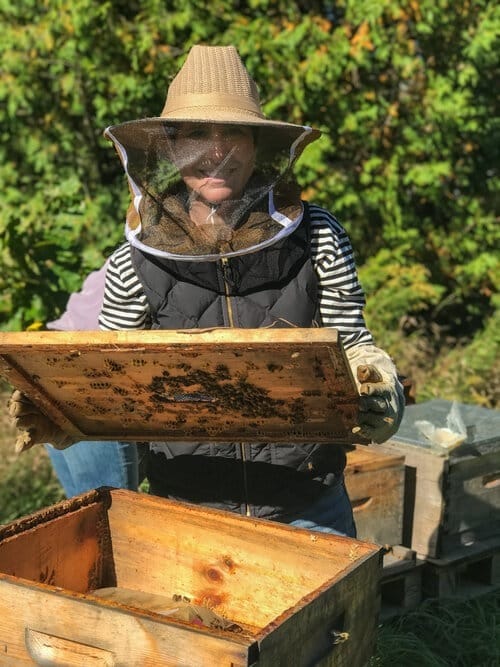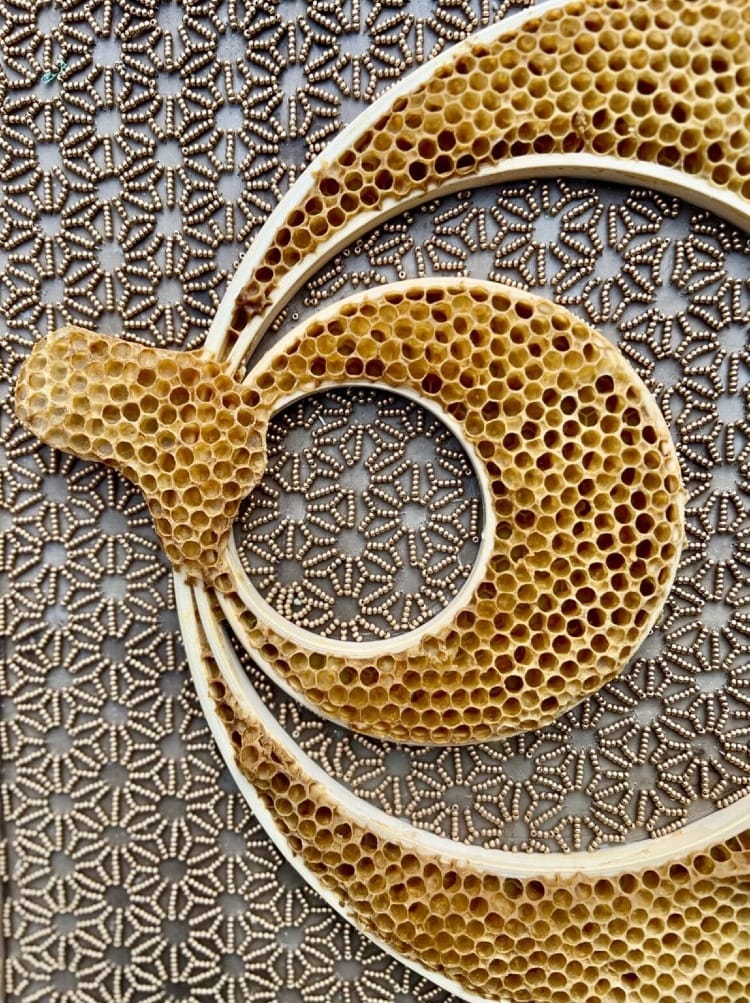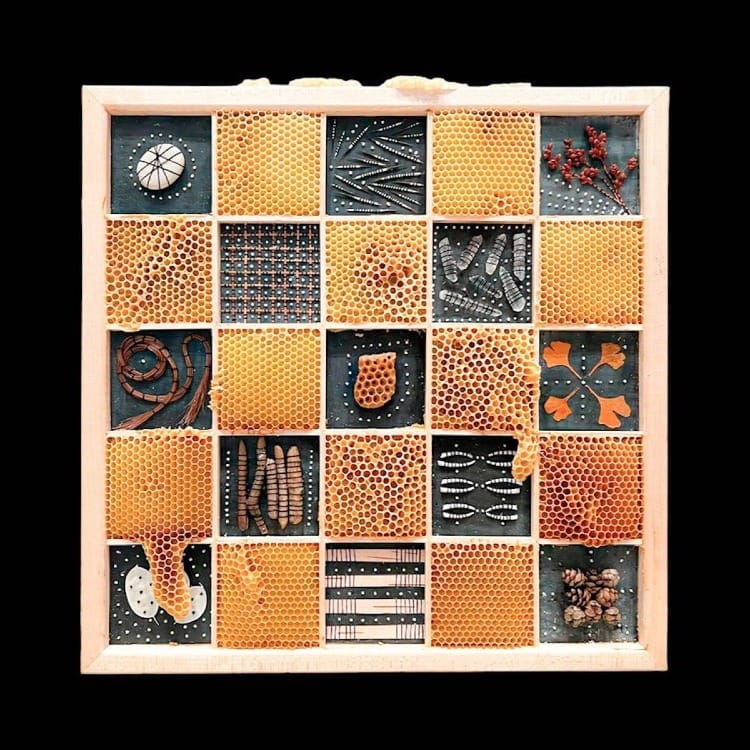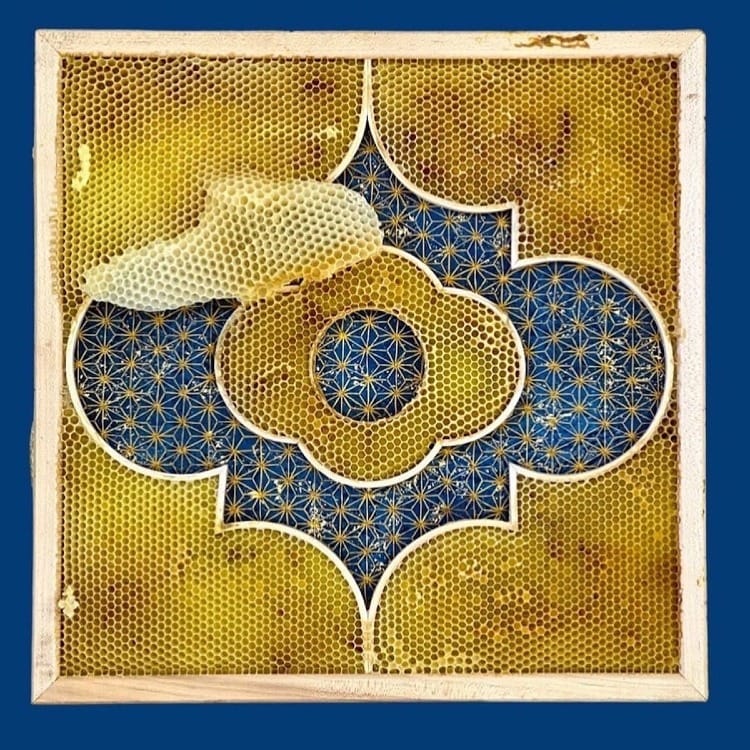Toronto, Canada-based artist Ava Roth does not work alone, but works with partners who are hard-working and creative, nameless and numerous. These small collaborators are tens of thousands of worker bees living within beehives in which she places the creative work she has begun, with the expectation and hope that they will bring that work to completion.
For her ongoing "Honeybee Collection," Roth stitches geometric patterns onto Japanese rice paper using wooden hoops, beads, beeswax, and various pieces of natural material—all materials she is confident will not harm the hive nor the bees. Thus, she creates her part of the work. When she has completed this, she hangs her piece within the frame of a beehive and leaves it up to her collaborators to finish off the project as they see fit.

Highlighting Bees
Roth takes the element of collaboration seriously, and as an opportunity to draw attention not just to her own creative ability, but also to the creative ability of the bees.

Roth began this series through her use of beeswax in paintings and other works of art. As an encaustic artist (someone who heats up and uses beeswax to fuse layers of wax in their art), beeswax had become her sole medium of choice. Over time, she became more curious about the creatures creating the beeswax she was using in her art, beyond just being producers of her art supplies.
She became more aware and concerned about them as creatures under threat, particularly the threats they are under such as the Colony Collapse Disorder. With bees often being considered an indicator of planetary health in general, one desire she has for her art is that brings them to people's consciousness and broadens the concern for them. With the honeycombs front and center in her collection, it is a gentle, but powerful reminder of the bees, what they contribute to the ecosystem, the importance of protecting them, the fascinating creatures they are.
Welcoming Uncertainly
Although she can encourage the bees to build honeycombs in particular areas by adding a bit of the bees' melted wax (which tends to encourage them to build combs in that space), she never knows how the work will actually turn out. Sometimes the bees leave bare spots; sometimes the combs spill over the sides of the hoop into other areas. Sometimes the honey is darker, sometimes lighter, depending on the flower nectar it is gathered from. (Although it can stay edible for decades, honey also changes colors as it ages, so that the art pieces themselves will change appearance over time).

As she says, "Part of the beauty and thrill of this project is that it is truly a dynamic collaboration. I can suggest to the bees where and how I want them to build comb on the art, but ultimately they will do it their way – if and how they want. Colour, texture, depth and even location of honeycomb varies greatly from piece to piece, and it is always a thrill to see what they have made."
She also doesn't know how long it will take for the bees to fill in the canvas with their honeycombs since that depends on the health of the bees, the supply of nectar, the number of bees in the hive, and many other environmental conditions. Once Roth fixes her work to a beehive frame and inserts it into the hive, the worker bees (which are 99% of the bees in a hive and are all female) get to work, in a process which can take anywhere from three days to three weeks.
Since Roth lives in Toronto, where cold weather lasts for months, this is a seasonally-limited project, one that she can only do during the summer months, when the bees are actively creating honeycombs and producing honey. She uses other times of the year to prepare frames and other supplies that she will need once the weather warms up and she is able to work on these honeycomb projects. She gets help with the bees from a Master Beekeeper who has taught her about bees and how to care for them.

A Different Model
Roth has commented that the outcome of human/nonhuman interaction is often not a positive one, and she sees her honeybee collaboration project as a way to show a different picture of how this interaction can end up as a positive interaction. She sees her own work as bringing an image of hope, in which an interaction (or collision, as she calls it) results in a more beautiful outcome than is often the case.
"My intent with this project is to explore the boundaries of where humans collide with the natural environment and imagine a more beautiful outcome of this encounter. The collection is essentially hopeful at a time when there is so much despair at the state of the climate, and our role in its destruction."

Reflection Questions: Do you see opportunities around you for positive collaboration with the nonhuman world? Are there ways you are already doing some of this work?
You can find more of Ava Roth's work on her website.
Feel free to leave a comment below or contact me directly at louise.conner@circlewood.online.
Louise
Want to learn more?
Find out more or support our parent organization by clicking below.